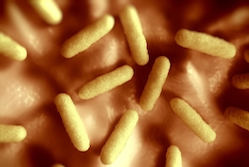Salmonella as a cancer cure?
Salmonella as a potential cancer treatment has made quite a few headlines over the past two years. Among the most notable breakthroughs was that of researchers from the University of San Diego (USA), who demonstrated that Salmonella typhimurium can inhibit or regress several tumour types in mouse models. As game-changing as it may sound, the idea of using bacteria to treat cancer is actually far from new. “The exploitation of bacteria on cancer patients has been studied for more than a century, first among all by William Coley, who established evidence that solid tumours may undergo regression after bacterial infection,” says Dr. Paolo Pasquali of the National Institute of Health in Italy. “The anoxic environment and the high concentrations of nutrients present in the necrotic area of the tumour indeed constitute a perfect niche for the growth of bacteria, and several studies have highlighted the great potential of salmonella typhimurium for cancer therapy.” Dr. Pasquali and his team have been playing their part in these exciting research efforts. Their research conducted a few years ago, into the creation of vaccines using a mutant strain of Salmonella enterica serovar Typhimurium known as STMΔznuABC, encouraged them to explore further. At the time the team was looking at vaccines for zoonotic diseases and they studied the host-pathogens immune response. With its reduced virulence, STMΔznuABC seemed like a suitable candidate for cancer therapy. So the team investigated its tumour-targeting efficacy, how it worked and the possibility of introducing it as an alternative treatment strategy. “Preliminary results have shown that the co-administration of subcutaneous mouse mammary adenocarcinoma cells and STMΔznuABC in immunocompetent mice led to a significant delay in tumour mass growth, as well as a significant increase of mice’s average life expectancy,” Dr. Pasquali explains. Similar results were confirmed when STMΔznuABC was administered after tumour implantation. In vitro studies, on the other hand, showed how STMΔznuABC can penetrate and spread into the tumour cell whilst inhibiting its proliferation. Last but not least, the team has demonstrated the ability of STMΔznuABC to reduce the frequency of lung metastases. From tests on mice to clinical trials Thanks to funding under the BACTHER project, the team could also investigate the hypothesis that STMΔznuABC can influence the tumour microenvironment (TME). They demonstrated STMΔznuABC’s capacity to recall more immune cells in the TME – both in primary and secondary metastatic tumours of treated mice compared to the untreated ones – and showed how it could induce modification of the TME and the systemic immune system. “Moving on, we demonstrated that STMΔznuABC has anti-tumour activity not only in syngeneic breast cancer mice model, but also on genetically engineered breast cancer-prone female mice and chemically-induced fibrosarcoma cancer mouse model,” Dr. Pasquali enthuses. In other words, a potential treatment based on STMΔznuABC could target many different types of tumours, all this at a much more affordable cost than alternatives. The BACTHER project is now completed, and the team are planning to publish their results in peer-reviewed journals. They also intend to participate in other European or international grants and, should new projects come out of this process, new treatments based on salmonella could one day become available. As Dr. Pasquali points out, a new category of antineoplastic agents could be developed should the mechanisms that make salmonella so efficient in killing tumour cells be elucidated. “We look forward to a possible clinical trial on pets – mostly dogs with mammary adenocarcinoma – since vertebrates more resistant than mice will be less susceptible to the residual virulence of STMΔznuABC. However, animal testing requires funding and comes with strict requirements on animal safety and welfare. Therefore, a few years ago, we started to disseminate our findings to European industries and mutual collaborations that are still ongoing,” Dr. Pasquali concludes.
Keywords
BACTHER, salmonella, salmonella typhimurium, bacteria, cancer, mice, virulence, STMΔznuABC







